 | E-mail to Birds Korea |
 | KWBS |
in the Region
 | The Oriental Bird Club |
 | BirdLife International (Asia) |
April
One of the very best birdwatching months! Cold days and nights (lowest day maxima of ca 12°C) gradually warm through the month (reaching the low 20s°C by month's end), and dry spells interspersed with 1-2 days of heavy rain and stormy conditions produce great birding towards month's end.
Early in the month, late Hooded Crane move through while shorebird numbers and diversity start to build up, with up to 200 000 shorebirds in the Saemangeum area by the end of the month, including up to 60 000 Great Knot, and small numbers of the globally-endangered Nordmann's Greenshank and Spoon-billed Sandpiper. Other Korean specialities, include Chinese Egret from mid-month, and Black-faced Spoonbill in small groups along the west coast. This latter species only has a world population of around 1400! In early April, species like Brown-headed Thrush and Japanese Robin occur regularly in very small numbers in the far southwest and southeast, while mid-April sees the first large passerine arrivals and spring overshoots, with good counts of many species like Blue-and-white, Narcissus and Yellow-rumped Flycatchers, and Tristram's and Yellow-browed Buntings. Late in the month, 100 or more species a day are possible on the outer islands like Heuksan and Gageo in the far south, Eocheong off Gunsan, and Socheong to the northwest.
Highlights in April have included several firsts and many unusual records for Korea, including Caspian Tern in the Nakdong estuary in 2001, Ferruginous Flycatcher and Eurasian Crag Martin on Eocheong Island in 2002, Northern House Martin and Red-breasted Flycatcher on Eocheong in 2003, and a Paddyfield Warbler on Hong Island in 2004.
(The following records are a compilation of our own sightings and records sent in by other observers. As well as being posted on the Birds Korea website(s), selected records are also forwarded to other Korean-language birding websites; records of threatened species are arranged and forwarded to Birdlife International and national authorities when appropriate; flag images and records are passed to bodies responsible for their coordination throughout the flyway; and all records sent to us are used to compile annual reports and to support the evolving understanding of the status of many of Korea’s birds.)
Songdo, April 29
At the lagoon, new migrants included 4 Sharp-tailed Sandpiper, 2 voraciously feeding Marsh Sandpiper, a Wood Sandpiper, 1 Long-toed Stint, and a Common Moorhen. Also present 306 Common Greenshank, 5 Red-necked Stint and 8 Black-faced Spoonbill.
At the Southern mudflat towards Sorae, species in increased numbers included an amazing 7500 Dunlin, 770 Grey Plover, 290 Whimbrel, ca. 100 Red-necked Stint, and ca.90 Common Greenshank.
Birds in decreased numbers were 4600 Great Knot, 1970 Bar-tailed Godwit, 40 Eurasian Curlew and only 3 Far-Eastern Curlew now remaining.
New to the count here were 3 sumptuous Red Knot. Also present were 10 "Eastern" Oystercatcher, 20 Black-tailed Godwit, 5 Mongolian Plover, 15 Kentish Plover, 1 Terek Sandpiper, 1 Pacific Golden Plover, 5 Ruddy Turnstone, and 41 Saunders Gull.
Eochong Island, April 29
Fewer birds today with many leaving under clear skies at night or early morning, as buntings and warblers were seen in numbers half of yesterday (for eg, 20 Yellow-browed Buntings and 20 Yellow-browed Warblers, 25 Black-faced Buntings, 15 Little Buntings and 1 Dusky Warbler).
It was, however, a day of exciting birds. Yellow Bunting was spotted in the military compound, and Grey Bunting was spotted twice. Excellent views of a Wryneck and a Pallas' Leaf Warbler, as well as one Pechora Pipit and 2 Ashy Minivet led to quality diversity. One Yellow Wagtail macronyx showed its brilliant colour in the much depleted 'lagoon'. Pacific and White-rumped Swift were seen overhead, while near the lighthouse a very friendly Siberian Thrush was enjoyed by all. On the way to the ferry, two Mugimaki Flycatchers added some colour to the day, and repeated close looks at Siberian Blue Robin had the photographers' fingers twitching.
The KWBS team also added a Little Whimbrel and Black-headed Bunting to the day's rarities.
Eochong Island, April 28
We were suprised to find birds at every corner under clear, warm sunny skies.
The ferry out had Ancient Murrelet and close looks at two Streaked Shearwater. On the island, buntings (50+ Black-faced, 25 Little, 20 Yellow-browed and 3 Tristram's) and warblers (70+ Yellow-browed, 15 Dusky, 3 Eastern Crowned Willow, 2 Arctic, 2 Greenish and 2 Asian Stubtail) were the most common. 50+ Red-flanked Bluetails were seemingly everywhere, while flycatchers were also quite numerous, with for eg. 10 Blue and White, 5 Yellow-rumped and 3 Asian Brown.
Major highlight for the day was a cracking male Black Redstart giving excellent extended views. Also, a Black-throated Thrush, Red-throated Flycatcher, 2 Bluethroat, 2 Siberian Rubythroat and one Black-legged Kittiwake, one Rufous-tailed Robin and a Japanese Grosbeak made the day a fantastic one.
Eocheong-do, April 24-27
3 days on Eocheong-do: a dry island, waiting for much-needed rain.
The ferry trip had 14 Streaked Shearwaters and 4 Common Terns. Relatively small diversity and numbers of birds. Highlights were:
April 24: 1 White-shouldered Starling, loosely accompanying 6 Red-legged/Silky Starlings. 2 Chinese Blackbirds. 1 adult male Grey Thrush. 2 Siberian Blue Robins. Several Scaly/White's and Pale Thrushes. Small numbers of Pallas' Leaf, Yellow-browed, Eastern Crowned, Dusky, and Pale-legged Leaf Warblers, an Asian Stubtail, and Japanese and Korean Bush Warblers.
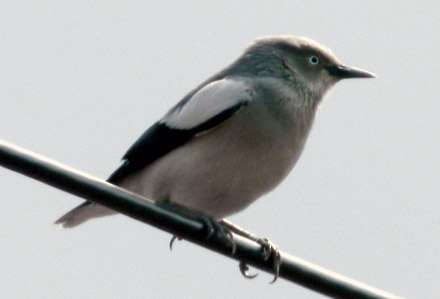
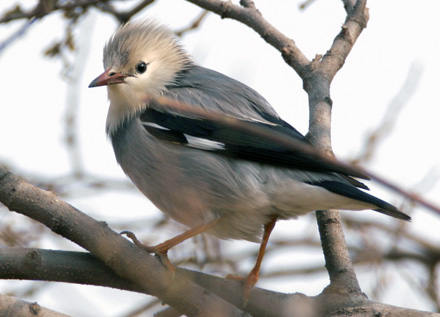
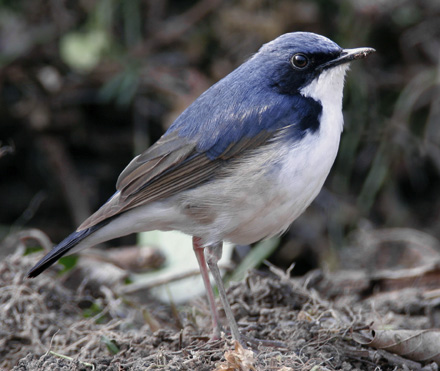
April 25: The Starlings still. New birds were a single Grey Bunting, an Oriental Reed Warbler, 20+ Yellow-browed Bunting, scattered groups of Black-faced, Little, and Tristram's Buntings and single Grey-headed and Yellow-breasted Buntings, 1 Eye-browed and 1 Brown Thrush, a Hawfinch, a Chinese Grosbeak, 2 Wryneck, 6 Pacific Swift, and 2 Asian House Martins.
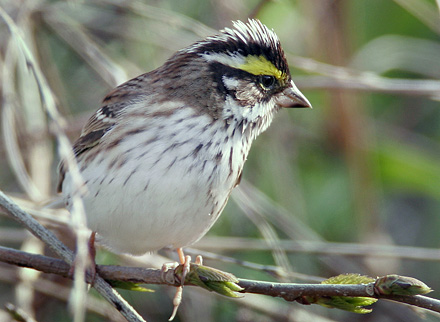
April 26: 2 Narcissus and 4 Tricoloured Flycatchers. 12 Siskin and 5 Bramblings. 1 Red-throated Pipit. 1 Hoopoe. 1 Ashy Minivet.
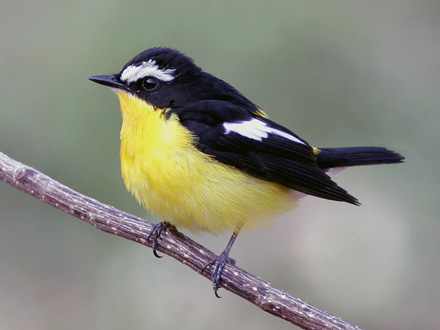
April 27: The return ferry on the 27th, over very calm and slightly foggy waters, was largely quiet. However, a group of 4 Murrelets in the middle distance provided interest: all 4 showed markedly broad white "headbands" as well as what appeared (allowing for mist light etc) to be slightly blue-grey backs, with a good contrast between the grey and black plumage. These features would suggest Crested Murrelets.
Okgu, Saemangeum Reclamation Area, April 24
Most notable record of the day was of two Spoon-billed Sandpiper - the first records of the spring.
Gunsan Vicinity, April 22
Covering a lot of territory today, we began at the Keum tidal area. Sharp-tailed Sandpipers and Red-necked Stints were there. Also seen there, Mongolian Plovers and a single Pacific Golden Plover and a flagged Bar-tailed Godwit (orange upper right flag, metal band on the lower left). Along the shore at least five Garganeys were observed. Chinese Penduline Tits were calling in the reeds.
Up river a few Meadow Buntings were singing. Near the Seong-san Reservoir a Grey Wagtail was seen. Also a group of a half dozen White Wagtail (ocularis subspecies) formed one homogeneous group. Still good numbers of Falcated Teals were on the water. A Common Kingfisher flew out from the shore. Near Oh-seong a Scaly Thrush sat on the road.
The Okgu Reservoir still has an Arctic Diver.
On the tidal area south of the industrial zone a Ruddy Turnstone was seen and a group of Red-necked Stints photographed by PN after a closer look had one apparent Spoon-billed Sandpiper.
A single Tristram's Bunting was seen in a ravine not far from the airport. Also there a few Pale Thrushes were observed.
Offshore from Haje Village we were excited to see an Avocet. We took the rare opportunity to watch it for some time. Despite that delay we recorded a robust 87 species day list.
Eocheong Island, April 22
About 70 species for the day in largely clearing conditions, with only Siskin (ca 600) in large numbers. Best for the day included excellent views of Little Whimbrel, single Chinese Egret, Marsh Sandpiper, Greater Short-toed Lark, Mugimaki and Yellow-rumped Flycatcher, 2 Chinese Blackbird, 2-3 Grey Thrush and 2-3 Wryneck, while rarest for the day was a single Northern House Martin.
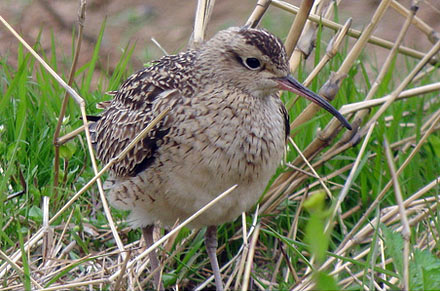
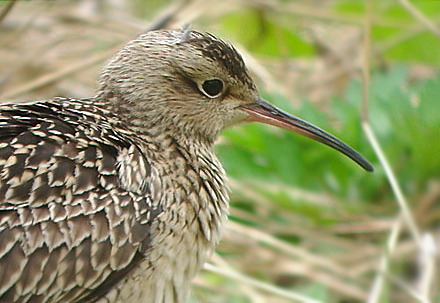
Ferry - Eocheong Island, April 21
From the ferry, the day's outstanding highlight: a single Long-billed Murrelet, starting to move from non-breeding into breeding plumage, seen on the water and then in flight by 6 or 7 observers at close range. While regular on the east coast in winter, this is perhaps one of or the first confirmed Yellow Sea record known to Birds Korea. Also from the ferry, 2 or 3 Northern Boobok (with one also seen in Iksan the same afternoon).
On Eocheong itself, rather few birds despite the cloud and fog, with highlights being a single male and female Narcissus Flycatcher, one Brown-headed Thrush, 2 Grey Thrush, and a Little Whimbrel photographed by Chai Seung-Hoon.
Songdo, April 22
New in at the lagoon were 6 Chinese Penduline Tits and 2 Green Sandpipers.
On the southern mudlat, birds in increased numbers included Great Knot (at least 5000), c. 4000 Dunlin, 4500 Bar-tailed Godwit, 530 Grey Plover, 19 Red-necked Stint, 11 Mongolian Plover, 50+ Whimbrel, 30 Common Greenshank (105 on the lagoon), and 2 Pacific Golden Plover. In apparently decreased numbers, 250 Far Eastern and 40 Eurasian Curlew, 35 Black-tailed Godwit, 54 Saunders Gulls, ca. 50 Kentish Plover, and 3 Eastern Oystercatcher. Also, at least 6 Black-faced Spoonbill.
New to the Songdo monitoring today were 6 Ruddy Turnstone, 4 Terek Sandpiper, 1 Grey-tailed Tattler, and a delightful flock of 140 Little Terns.
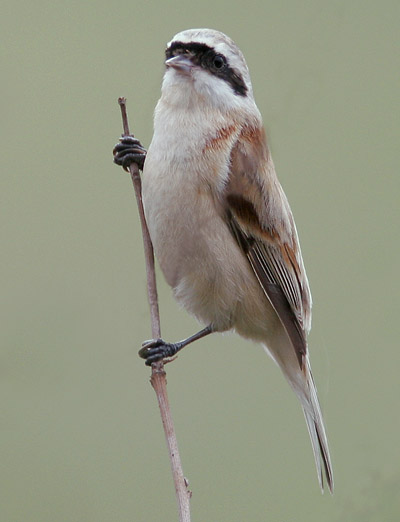
Saemangeum, April 20
Between April 9th and April 19th 2007, a total of fifteen people counted or assisted counting shorebirds within the 40,100 ha Saemangeum reclamation area (until April 21st 2006, comprising the free-flowing estuaries of the Mangyeung and Dongin Estuaries), Gomso Bay and the Geum Estuary, three adjacent intertidal wetlands on the west coast of South Korea. In addition, two teams of observers also traveled north to Asan Bay (Gyeonggi Bay) on April 16th to locate and photograph two Bar-tailed Godwits (E1 and E8) satellite tracked to Korea from New Zealand.
Data are here summarized from counts at Gomso Bay on April 19th; at the Geum Estuary on April 15th; and within Saemangeum, between April 15th and 18th (including boat-based counts on the 18th).
At Gomso Bay, two full counts were made, with the high tide count on April 19th producing 2,941 shorebirds, comprised largely of Great Knot (1664), Dunlin (720) and Far Eastern Curlew (315). This total compares with just a single shorebird found at the same site on April 15th 2006!
At the Geum Estuary, repeated counts at mainland sites were supplemented by simultaneous counts of both mainland and outer tidal-flat sites on April 15th. A total of 50,560 shorebirds were counted at this time, with most numerous being Great Knot (28,554), Dunlin (13,050), Bar-tailed Godwit (4029) and Far Eastern Curlew (1405), while 9 Nordmann's Greenshank (Endangered) were also recorded.
This total compares with only 45,731 shorebirds counted in the same area on April 17th, 2006, with much of the difference made by the very greatly increased total of Great Knot (only 10,429 in 2006), and lower numbers of both Dunlin and Bar-tailed Godwit.
A second day of research at Yubu Island during a very high tide of 6.7 m on April 18th produced a much larger estimate of 50,000 Great Knot and 9500 Bar-tailed Godwit, as well as 16 Nordmann's Greenshank and 50 Saunders's Gulls (Vulnerable). These latter counts are not included in the totals here, as they were not part of a simultaneous counting effort.
Within the Saemangeum area, land-based counts by four teams were supplemented by a boat-based count on April 18th. In total, 69,441 shorebirds were counted, with 29,801 at the Mangyeung and 39,640 at the Dongjin (this compares with a rather similar total of 71,709 shorebirds counted within the Saemangeum area between April 15th and 17th 2006). Most numerous were Great Knot (6188 at the Mangyeung and 25,727 at the Dongjin) and Dunlin (19,212 at the Mangyeung and 10,678 at the Dongjin).
Based on leg-flag observations (including several birds flagged in northwest Australia and at Chongmin Dao in the Yangtze Estuary), it appears that some of this similarity in numbers year to year might be in part the result of Great Knot building in number here this spring earlier than in 2006, possibly due to more favorable weather conditions during migration allowing birds to reach the Korean west coast earlier? The third count cycle, in early May, should be useful in confirming or refuting this.
While Saemangeum remains of considerable international importance to shorebirds, conditions within most of the reclamation area continue to deteriorate, with open expanses of desert-like dried-out sandflats and severe water quality conditions prevalent in many wet areas leading to red algal bloom puddles in muddy areas, dense gravy-brown waters in some bays, and thick scum and dried foam in creeks and channels. The recent tidal range is estimated at only 17 cm, and only one significant area of tidal-flat (lying far out in the Dongjin) appeared relatively healthy, supporting 18,820 Great Knot and 2745 Dunlin on April 18th. Many other areas used by shorebirds in 2006 and in March and early April 2007 are becoming narrower and drier, and some such areas supported significantly fewer shorebirds between the first and second count cycles this year.
Solleung Tombs (Seoul), April 18
A few hours at Seoul's Solleung Park: few migrants in general; the highlights were thrushes. Only a few Dusky Thrushes around, but at least 20 Pale Thrushes, 8 Scaly/White's Thrushes, and (most surprising) a handsome Grey Thrush.
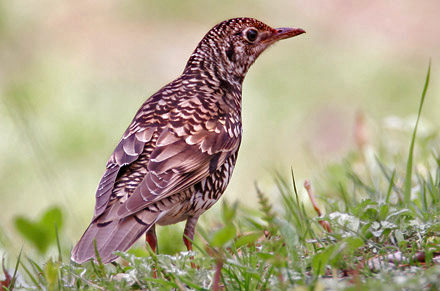
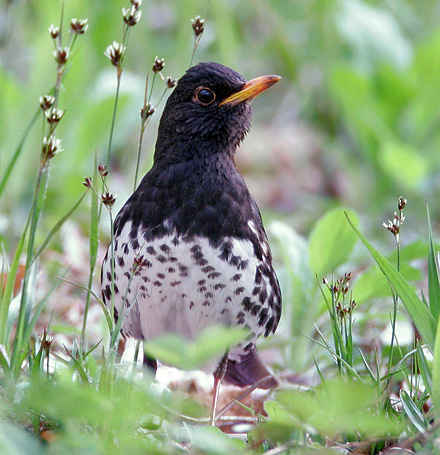
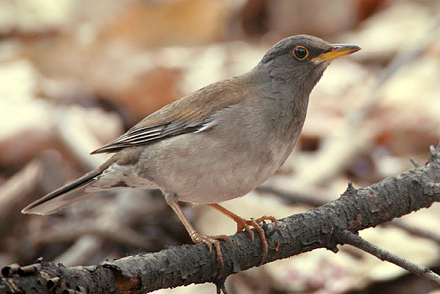
Songdo, April 17
With the tide out at Aham-do, only a scattering of Grey, Kentish and Little Ringed Plovers.
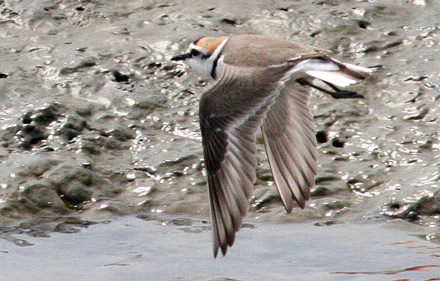
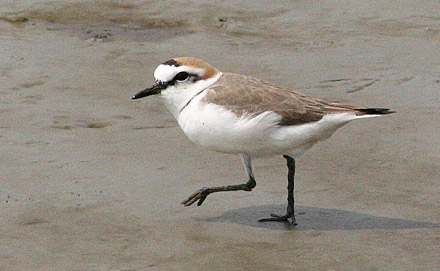
On the golf course, 14 Siskin and 2 Olive-backed Pipits still, with several Red-flanked Bluetails, a Scaly/White's Thrush and up to 10 Pale Thrushes in residence.
Shiripdae, April 16
In deciduous woodland, the personal first Pale-legged Leaf (1) and Eastern Crowned Warblers (3) of the spring. Also a pair each of Scaly/White's Thrush and Red-flanked Bluetail.
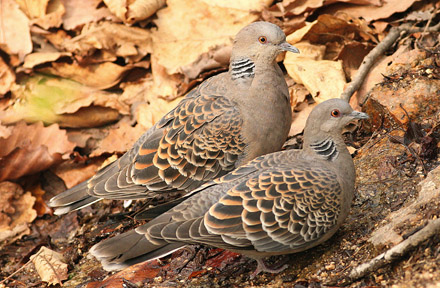
Asan Bay (Gyeonggi Bay), April 16
With heavy rain in the morning, and repeat satellite transmission signals revealing that now two of the New Zealand Bar-tailed Godwits are in Asan Bay (after a direct flight of nearly 10000 km!), two teams from the SSMP travelled north to the site, and successfully located and photographed both birds. This is perhaps the first time for godwits to be found in Asia in this way. More details and images will be posted soon.
Okgu, Saemangeum reclamation area, and Yubu Island, Geum Estuary, April 15
With four teams of counters this day, lots of great data. Highlight of the day was at least 9 Nordmann's Greenshank back on Yubu Island, where 39,000 shorebirds were present just before high tide, with most numerous Great Knot (ca 23,000), and Dunlin (11,000). Much fuller details will be posted later.
Geum Estuary, April 14
Among large numbers of birds present, highlights included the first Broad-billed Sandpiper of SSMP07 (at the barrage) and a Greater Ringed Plover (near Wulpo) - the latter presumably the same individual as found and photographed 2 weeks previous in the same area by Peter Nebel.
Seungbongdo, April 14-15
An afternoon and morning only at Seungbongdo found sparse numbers of migrants, perhaps because the hoped-for overnight showers did not arrive.
Perhaps most interesting bird was from the ferry just out of Incheon--a single Common Tern.
On the island, highlights were: 5 each of Olive-backed and Buff-bellied Pipits, 2 Siskin, 400+ Brambling, 2 Yellow-browed Warblers, 3 Japanese White-eyes, 2 Grey Wagtails, 5 Oysterctachers, 1 Japanese Sparrowhawk, 30 Dusky and 3 Scaly Thrushes, 2 Pale Thrushes, including one very tangled but feisty individual rescued from a mesh garden fence, 10 Stonechats, 1 Zitting Cisticola, 20 Red-flanked Bluetails, 30 Black-faced Buntings, 2 Kingfishers, and 1 apparent Sand Martin, rather poorly seen but well heard.
Songdo, April 14
Lagoon: 11 Black-faced Spoonbill (sporting pretty yellow crests and neck bands) rested up. 43 Common Greenshank are fresh in. Also 3 Eurasian Wigeon, 2 Black-faced Buntings, a Pale Thrush and a good scattering of Red-eared slider terrapins Trachemys scripta elegans sunning themselves.
Southern mudflat: 3 hours walk along the edge towards Sorae at high tide revealed increased numbers of shorebirds. Massed flocks of waders ranked thick on the ground, often flying up en masse in spectacular aerial maneouvres. At least 3200 Dunlin, 2050 Great Knot, 1430 Bar-tailed Godwit, 870 Far-eastern Curlew, 410+ Grey Plover, 220 Kentish Plover, and 200 Eurasian Curlew. 12 Whimbrel, 4 Mongolian Plover, 1 Pacific Golden Plover, and surprisingly 140+ Black-tailed Godwit are newly arrived. Also seen were 3 Common Sandpiper & 2 Common Greenshank. Only 75 Saunders's Gull suggests that most are probably busy on the breeding colony at Ahamdo now.
Significantly, 2 Black-faced Spoonbill were on the flat and the first Chinese Egret of the spring, employing the characteristic crouched 'sumo" stance, with legs bent sharply back at the knee.
Igidae, Busan, April 13
Following a heavy thunderstorm, three hours at Igidae produced ca 50 Pale, three Brown-headed and two Grey Thrushes, 8 Blue-and-White and a single Asian Brown Flycatcher, and 2 Pale-legged/Sakhalin Leaf Warblers as obvious highlights.
Eocheong Island and ferry back to mainland, April 11
A pleasant and warm early morning, becoming thick with fog by midday. A few more birds in, with 5 or 6 Red-billed Starling, 2 Brown-headed Thrush, a Red-rumped/Lesser Striated Swallow, and e.g. single Bluethroat, Latham's Snipe and Chinese Blackbird from the day before, as well as now 5+ singing Pallas's Leaf Warbler, 15 White's Thrush etc.
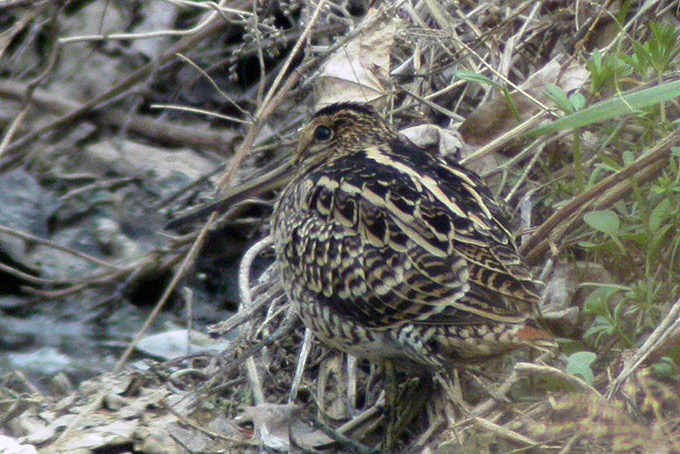
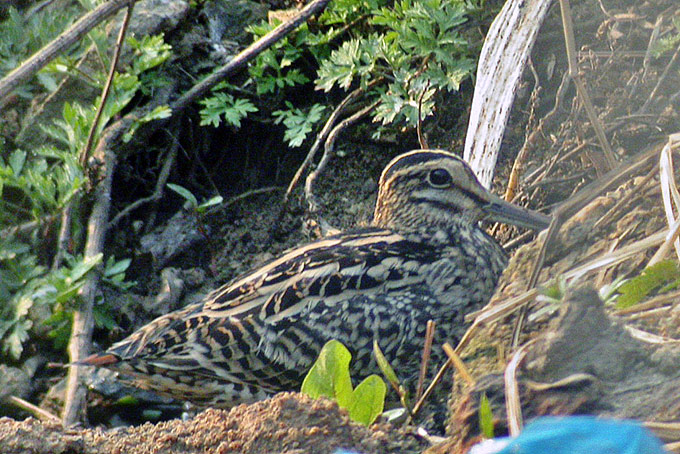

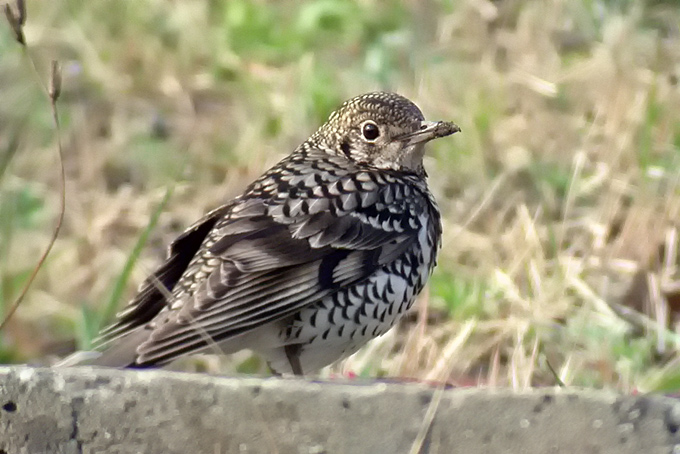

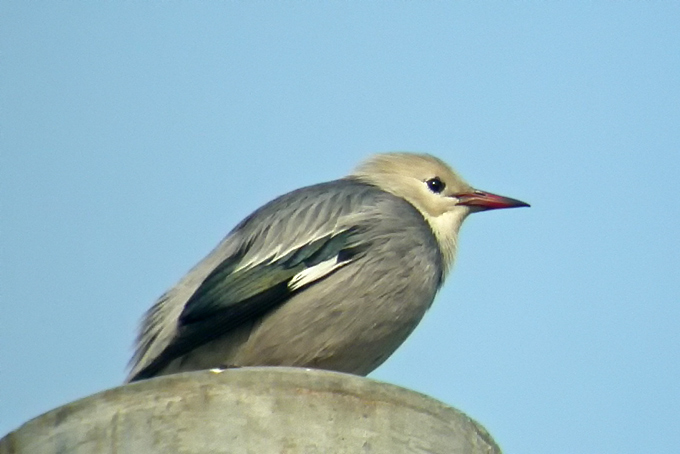
All photos © Nial Moores/Birds Korea
On the return ferry, becoming clearer half way back to Yeong Do, allowing views of 4 Streaked Shearwater and ca 12 Ancient Murrelet (with sadly no sign of the possible Crested of two days before), as well as three or more Finless Porpoise.
Geum area and Saemangeum, April 1 - 10,
April 10th proved to be quite the day for the daily counts of the six locations along the inner and outer Geum. Great Knot arrived in mass numbers, taking the previous high total of 6,624 (April 07, with Tabitha Davis), to a total of 15,918 (April 10). Along with them were the season's first Red Knot (4). This is the same day Great Knot arrived in mass numbers last year …
Dunlin also peaked at 14,149, while Bar-tailed Godwit peaked at 3,078 for land-based counts. The total number for the 10th was 35,313, almost doubling the previous high during the count period.
Ruddy Turnstone ( 1, April 10th) and Sharp-tailed Sandpiper (1, March 29th) have also joined the daily count charts, bringing the species count for SSMP purposes to 12.
In other bird news, Red-billed Starling were spotted at Wulpo Harbour on April 06 (with Tony Crocker, Andrew Patrick, Song Ha-chul and Cheong Seok-wan), and one Common Ringed Plover was seen at the south end of the Gunsan airport strip (GS and TD). Also on the airport strip were 3 Black-faced Spoonbills with 6 Eurasian Spoonbills. The over-wintering Whiskered Terns were spotted again on Okgu reservior, as well as Red-throated Diver (Nial Moores, GS, TC, AP and Ju Yung-gi). A possible Red-throated Thrush was spotted at Oh-seong mountain pond on April 09 (GS), pending further views of undertail coverts …
In all, a great start to the SSMP 2007, with many volunteers joining already, and room for many more to join in the coming 5 weeks!
Gangnam (Seoul), April 10
A brief visit to Gangnam's Solleung Tombs found a trickle of migrants: 6 Red-flanked Bluetail, a Rustic Bunting, 5 Dusky (but no Naumann's!) and 1 White's Thrush, and a cracking male Blue and White Flycatcher.
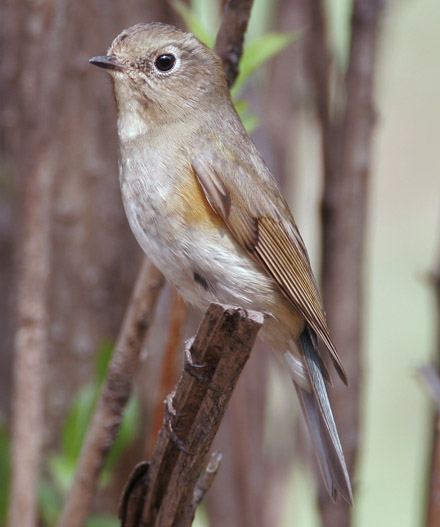
Eocheong, April 10
In sunny and slightly warmer conditions, a few more birds. Best for the day were now two Bluethroat, two Chinese Blackbird and a Latham's Snipe, while new for the spring included two Siberian Blue Robin, Asian Stubtail, an Ashy Minivet and two or more Eastern Crowned Warbler.
April 09, Eocheong
On the ferry, in thick fog banks, two Streaked Shearwater, 7+ Ancient Murrelet, and one close murrelet sp (either an extremely white-browed Ancient or a Crested) watched flying away from the boat into the dense grey. On the island itself, rather quiet, with best being single Brown-headed Thrush and Bluethroat.
Songdo (Southern mudflat), April 8
At high tide this morning, 2800 Dunlin, c.800 Great Knot, 650 Far Eastern Curlew, 30 Eurasian Curlew, 320 Bar-tailed Godwit, 180+ Saunders Gull, 9 Eurasian Oystercatcher, 280+ Grey Plover, ca.170 Kentish Plover, 12 Little Ringed Plover, 2 Red-necked Stint, 1 Common Sandpiper, & 1 Common Greenshank.
Saemangeum, April 8
Following near-daily counting of the Geum Estuary since March 10th, the Saemangeum Shorebird Monitoring Program (SSMP) 2007 started formally on April 2nd.
Between April 2nd and April 8th, a total of 17 people counted or assisted counting shorebirds at the Geum Estuary (on several dates, with a coordinated simultaneous count on April 4th), Gomso Bay (April 2nd only), and within the Saemangeum reclamation, especially on 7th and 8th (when calmer weather conditions finally allowed some boat-based counting).
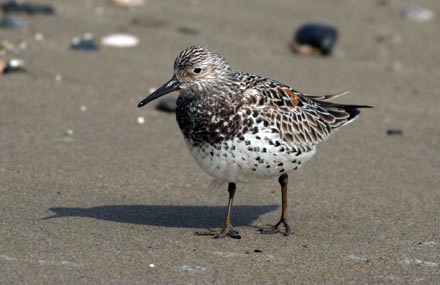
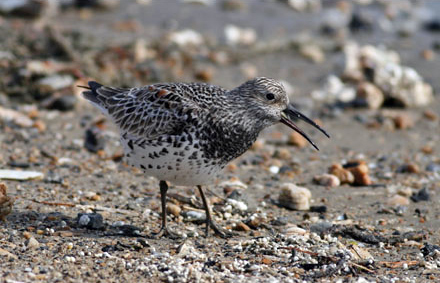
While data and leg-flag sightings are still being processed, preliminary results of the counts so far are as below:
Good coverage of Gomso Bay on April 2nd found a total of 1,805 shorebirds, with the vast majority Dunlin (1,627) - a far higher count than achieved at any time there during SSMP 2006.
At the Geum Estuary, repeated counts were made with a coordinated count on April 4th of land-based points and on Yubu Island. In total, 25,982 shorebirds were counted on the 4th, with most numerous being Dunlin (16,641), Great Knot (2,872), Bar-tailed Godwit (2,462), Grey Plover (1,081), Far Eastern Curlew (786) and Eastern Oystercatcher (650). Counts of 168 Sanderling and 46 Ruddy Turnstone were also made. Several individually color-banded Bar-tailed Godwits have been found (one on at least four occasions, in the same area), as has E0, a female Bar-tailed Godwit that had a satellite transmitter placed on it at the nest in the Yukon Delta in summer 2005. Despite the transmitter not working, this same individual has been seen in New Zealand (in both 2005/2006 winter and 2006/2007 winter), again in Alaska (summer 2006) and now at the Geum - twice so far this spring.
Counting within Saemangeum is proving, as expected, rather more difficult. Coordinated coverage on April 8th of the whole outer Mangyeung estuary between the seawall and tidal-flats off Okgu, followed by counting at Hwapo, produced 20,408 shorebirds (clearly, the area is still internationally important according to Ramsar guidelines), with most numerous Dunlin (16,806), followed by Grey Plover (1,154) and Kentish Plover (468). Only 393 Great Knot were logged, most appearing emaciated.
Coverage of the Dongjin estuary has been less comprehensive so far, with counts conducted by boat and at two of the former best land-based sites on 7th and 8th producing only 3,932 shorebirds, with most numerous Great Knot (2,066).
Gunsan vicinity, April 7
There was a Mandarin Duck sitting on the edge of the reservoir at the base of Oh-seong Mountain. Scaly and Pale Thrushes were calling there. At least one Whiskered Tern remains at the Okgu reservoir. Little Terns have appeared off of Ha-je. A single Common Redshank was the best bird there, as well as a single Great Knot. In a pond near the city reservoir a single male Garganey was flushed. Chinese Penduline Tits were encountered there and also by the Keum. A personal first Siberian Stonechat for the year was near the airport.
Saemangeum, April 2
In cold, windy, but rather clear conditions, preparatory counting at the outer Geum (Geoff Styles, Phil Battley, Tony Crocker, Andrew Patrick and Nial Moores), and coverage of Gomso Bay.
At the latter site (TC and NM) a strong suggestion of displaced birds - with counts of Dunlin (1,627), Great Knot (18), Far Eastern Curlew (121) and Bar-tailed Godwit (34) all much higher than counts of the same species made here during SSMP 2006 in April.
Weiyeon Island-Geum Estuary, April 1
A morning on the island produced several interesting species, with 2 Japanese Quail (GS only), 3 Grey-faced Buzzard, 2 Long-tailed Rosefinch and a single Chinese Grosbeak. While numbers of Siberian Stonechat were down (only 15), numbers of Red-flanked Bluetail (2 on 31st, increasing to 20 on 1st) and Dusky Thrush (60) were well up.
Outstanding highlight came shortly before the lunchtime boat back to the mainland: a blakistoni Water Pipit, poorly photographed (due to the 'yellow dust' haze) in the same spot as an elusive Water Pipit-type bird seen very briefly on 31st...
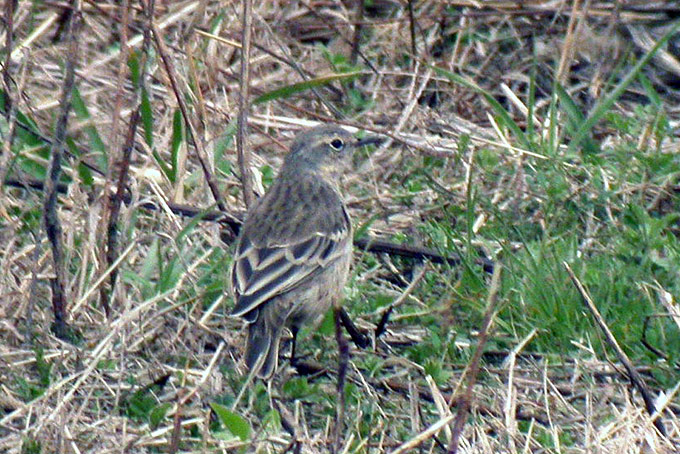
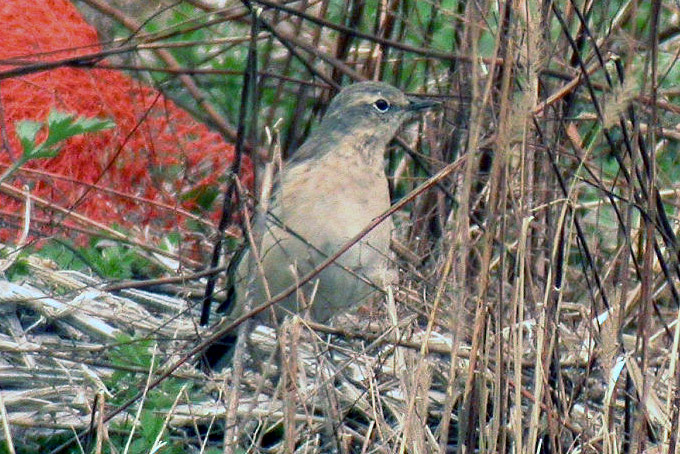
At the outer Geum, already 5200 Great Knot, 5037 Dunlin, 3080 curlew (probably >2500 of which were Far Eastern) and 625 Bar-tailed Godwit (including one menzbieri seen in flight, one yellow-flagged bird, and the same individually color-banded Bar-tail as seen twice before at the Geum by GS earlier in the week).
Songdo, April 1
On the southern mudflat (towards Sorae) at high tide, 3000 Dunlin, 225 Bar-tailed Godwit, 677 Far Eastern Curlew, 40 Eurasian Curlew, 800 Great Knot, 230 Saunders Gull, 37 Eastern Oystercatcher, 35 Kentish Plover, 5 Little Ringed Plover, 50 Grey Plover, and 3 Common Greenshank.
On a separate, largely reclaimed area near the lagoon, 44 Gadwall and 10 Wigeon were all time high counts of these particular ducks for this site.





